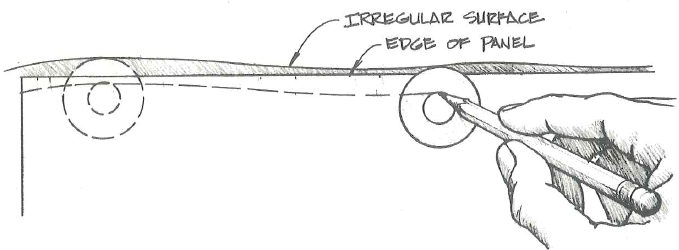
by Brian Knight—GBI Technical Advisor
Most woodworkers, at one time or another, have to scribe a piece of wood to fit closely to an irregular surface. Here is an old boat builder’s method to scribe a line to a gently curved surface. The only equipment necessary is a collection of different size flat washers and a sharp pencil.
As an example, I will describe how to fit the upper surface of a piece of wall paneling to a ceiling so no molding is required. Although most ceilings appear to be flat, they all have some gentle contours, and in order for the panel to fit tightly, you need to trim the top edge of the panel to fit that contour. The only tricky part of the entire procedure is marking the top edge of the panel parallel to the ceiling.
To mark the panel, tack it to the wall so it is plumb, and close to or even touching the ceiling. Usually the panel will only touch in one or two spots with gaps remaining in the other areas. From your collection, select a flat washer that is just large enough (measuring from the outside diameter to the inside diameter) to cover the widest part of the gap. Set the washer against the ceiling at one end of the panel, put your pencil in the hole of the washer, and roll the washer along the ceiling making sure it remains in continuous contact with the ceiling. Your pencil will automatically draw a line parallel to the ceiling on the face of the panel. After marking the panel, remove it from the wall, then saw, plane or sand it to the mark and install it permanently.
This trick works well on gently curved surfaces but a flat washer does not accurately reproduce the shape of sharp, outside corners, sharp indentations or excessive surface irregularities. Intricate shapes will require other scribing techniques.





